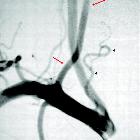thyroidea ima artery



The thyroidea ima artery is an uncommon variant of the blood supply to the inferior aspect of the thyroid gland. It is reported in ~7.5% (range 1.5-12.2%) of individuals and can arise from:
- brachiocephalic trunk (most common: 1.9-6.0%)
- right common carotid artery
- aortic arch
- internal thoracic artery
- subclavian artery
The thyroidea ima artery ascends on the anterior surface of the trachea and supplies both the trachea and thyroid and may terminate as a single trunk or as multiple bifurcations.
It is often associated with absent inferior thyroid arteries. When an anomalous artery arises from the subclavian artery directly, rather than from the thyrocervical trunk, it is referred to as an accessory inferior thyroid artery, rather than a thyroidea ima artery.
Clinical significance
The clinical significance of the thyroidea ima artery becomes clear during head and neck surgery, particularly thyroidectomy. If unrecognised it can be a source of brisk and potentially difficult to control bleeding, as the cut vessel may retract behind the manubrium.
History and etymology
First described by Neubauer in 1786 and was originally called the thyroid artery of Neubauer.
Siehe auch:

 Assoziationen und Differentialdiagnosen zu Arteria thyroidea ima:
Assoziationen und Differentialdiagnosen zu Arteria thyroidea ima:




